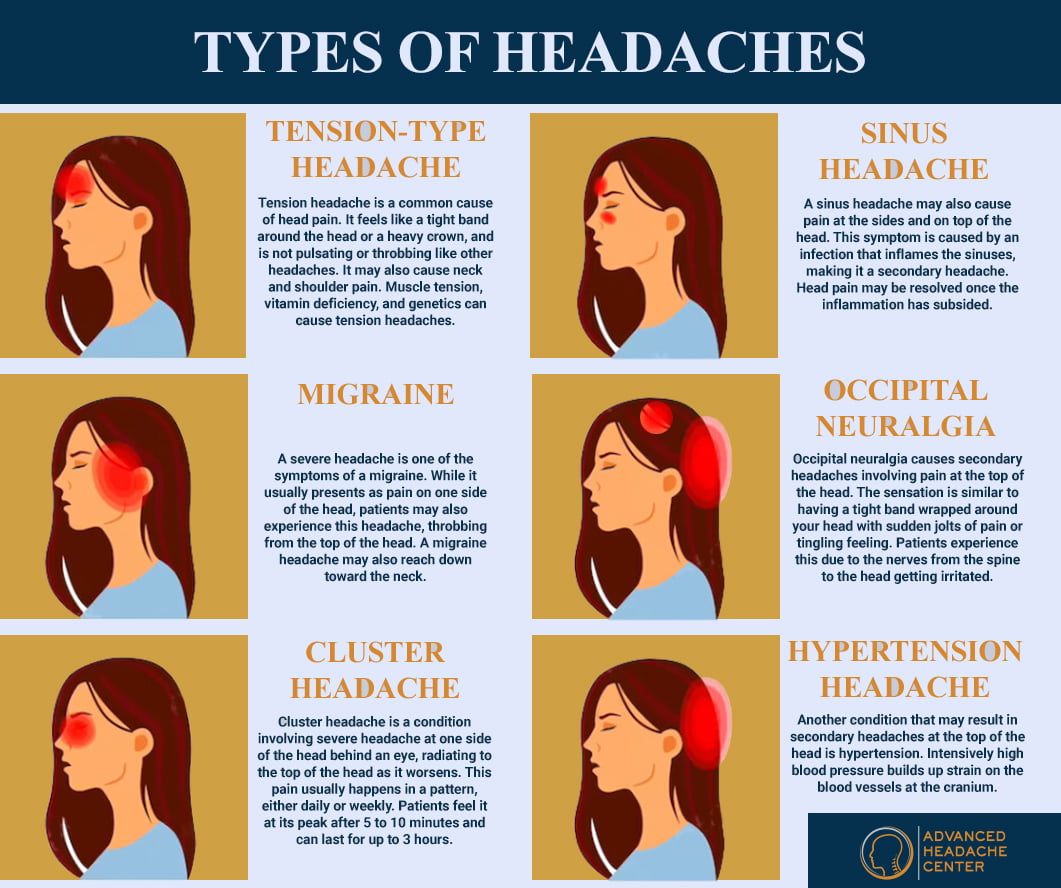Headaches can give you the utmost discomfort that puts your daily activities to a halt, affecting your quality of life. This is especially when you experience the type of head pain you know isn’t just a common headache, like localized pain at the top of your head. Patients report sensations of having a tight band around the head or wearing a heavy crown.
So why do you experience headaches at the top of your head? Headaches on top of the head are caused by neurotransmitters delivering pain signals to the brain from the head, neck, and face due to muscle constriction, enlarged blood vessels, stress, and other stimuli. It may be a sign of migraine, tension-type headache, cluster headache, sinus headache, occipital neuralgia, or hypertension headache.
Why the Top of Your Head Hurts
Various reasons may cause headaches on top of your head. It mostly starts with the nerves in the muscles and blood vessels surrounding the head, face, and neck. These nerves sense pain triggered by muscle tightness, enlarged blood vessels, stress, and other stimuli. The nerves release neurotransmitters to deliver pain signals to the brain, resulting in head pain.
To control the headache on top of your head, you must consult a specialist to determine the triggers setting off pain signals from your nerves. Your condition might be a primary headache, where head pain becomes your main problem. It might also be a secondary headache, making it a sign of an underlying medical condition.

Probable Types of Headache and Other Disorders Behind the Pain on Top of Your Head
Experiencing a headache on top of the head may simply be caused by sleep deprivation, engaging in sudden, vigorous exercise, or having a brain freeze. But it might already be a different case if your head pain isn’t triggered by any of these at all, happens frequently, and gets painful. A severe headache may be a sign of a primary headache disorder. It may also be a symptom of an underlying medical condition, making it a secondary headache.
Some probable types of headaches and other disorders behind localized head pain are tension headaches and migraine. This symptom might also be a cluster headache or sinus headache, or your doctor may suspect occipital neuralgia or hypertension headache.
1) Tension-Type Headache
Tension headache or tension-type headache is one of the most common causes of pain at the top of the head. It involves mild to moderate pain similar to having a tight band wrapped around your head or wearing a heavy crown. This sensation is only dull and not a pulsating or throbbing pain, like other headache disorders. Patients may also experience shoulder and neck pain
Muscle tension, vitamin deficiency, and genetics may have caused tension-type headaches. While you usually won’t get a severe headache from this condition, the pain can still be uncomfortable and may disrupt your daily activities.
2) Migraine
A severe headache is one of the symptoms of a migraine. While it usually presents as pain on one side of the head, patients may also experience this headache, throbbing from the top of the head. A migraine headache may also reach down toward the neck.
3) Cluster Headache
Cluster headache is a condition involving severe headache at one side of the head behind an eye, radiating to the top of the head as it worsens. This pain usually happens in a pattern, either daily or weekly. Patients feel it at its peak after 5 to 10 minutes and can last for up to 3 hours.
4) Sinus Headache
A sinus headache may also cause pain at the sides and on top of the head. This symptom is caused by an infection that inflames the sinuses, making it a secondary headache. Head pain may be resolved once the inflammation has subsided.
5) Occipital Neuralgia
Occipital neuralgia causes secondary headaches involving pain at the top of the head. The sensation is similar to having a tight band wrapped around your head with sudden jolts of pain or tingling feeling. Patients experience this due to the nerves from the spine to the head getting irritated.
6) Hypertension Headache
Another condition that may result in secondary headaches at the top of the head is hypertension. Intensively high blood pressure builds up strain on the blood vessels at the cranium.
Diagnosing the Condition Behind Pain on Top of Your Head
Taking over-the-counter pain medications and trying other home remedies can help ease the discomfort on top of your head. But if it has progressed into a persistent headache that keeps you from doing what you love, you might need medical attention.
Consult your healthcare provider to get to the bottom of your frequent headaches and receive a holistic treatment plan. Identify the type of pain, concurring symptoms, and causes or triggers. Your doctor will request laboratory and imaging tests to confirm their diagnosis and rule out other conditions.
1) Identify the Type of Pain You Have
As established, each type of headache disorder has its specific pain or sensation, from a dull feeling to throbbing pain. Identifying the type of pain you experience allows you and your healthcare provider to arrive at a probable diagnosis soon enough.
Describe your symptoms in detail the best you can to make your consultation as productive as it can get. It helps to keep a journal where you can log in the description of your headaches with the other details.
2) Know Your Other Symptoms
Headache disorders come with other symptoms, aside from pain at the top of the head. Your specialist will interview you about these details. You might want to take note of all other signs you experience, logging them in your journal.
You should also be attentive to the frequency of your headache attacks. It might be an episodic headache, where the head pain occurs within less than 15 days a month. Chronic headache happens when you get frequent headaches for 15 days or more a month.
3) Determine the Causes or Triggers
The pain on top of your head may be triggered by the food you just ate, stress, and other environmental and lifestyle factors. Determining this will greatly help your consultation and identify the type of headache you’re suffering from.
4) Take Laboratory and Imaging Tests
Your specialist will request laboratory and imaging tests after gathering your medical history and holding a physical examination and interview. These tests will provide them with detailed images of your head. While laboratory and imaging tests won’t show the cause of your headache, the results will be reliable for ruling out other conditions, like tumors, brain aneurysms, and other conditions.
Some tests you’ll likely have are:
- Blood tests
- Urinalysis
- Lumbar puncture
- X-ray
- CT scan
- MRI
Treatment Options for Headache at the Top of the Head
Your specialist will then prepare a long-term treatment plan once they’ve diagnosed the condition behind your recurrent headache. Some disorders don’t have a cure yet, so management and interventional solutions to control the pain are crucial to improve your quality of life. Because of this, you might greatly benefit from a comprehensive and integrated treatment by Advanced Headache Center.
1) Multimodal Approach
Advanced Headache Center adopts a multimodal approach to treating a broad range of pain and headache disorders. This framework provides the patient with a comprehensive treatment plan that isn’t limited to pain relief medications. Harvard-trained specialists will also apply non-pharmacological solutions to promote headache relief, from chiropractic care and physical therapy to injectable prophylaxes.
2) Rational Polypharmacy
Rational polypharmacy is also one of the comprehensive approaches that Advanced Headache Center adopts. Your specialists will prescribe medications that aren’t heavily reliant on pain medicines. Patients can expect their treatment plan to avoid adverse reactions.
3) Injectable Treatments
Getting a holistic and integrated treatment plan also involves interventional treatments by administering medications and nerve blocks as prophylaxis to headaches.
Some procedures that may be prescribed for you are:
These treatments involve administering local anesthetics, anti-inflammatory solutions, muscle relaxants, or nerve blocks to relieve and prevent headaches. Your specialist will prescribe the right procedure according to your condition.
4) Intravenous Infusions
Specialists may also prescribe IV infusion therapy if you have some hesitations about taking pain medicines. IV infusions for headaches involve administering vitamins, minerals, and electrolytes to help resolve inflammation, nausea, and pain. These solutions also reduce nerve-ending oversensitivity.
5) Physical Therapy
Headache disorders caused by muscle tightness and other musculoskeletal issues, like spinal disc problems and poor posture, can be treated with physical therapy. Patients can expect a treatment program customized according to their condition.
6) Chiropractic Care
Patients with headache disorders from vertebral misalignment resulting in nerve interference will greatly benefit from chiropractic solutions. This option aims to promote spinal column function, relieving head pain.
7) Acupuncture
Overstimulated nerves also cause headaches and migraine attacks as they release pain signals to the brain. Acupuncture is another way to help relieve these symptoms as it stimulates the release of hormones, like endorphins, and promotes healing.
Book an Appointment at Advanced Headache Center for the Headache at the Top of Your Head
Headaches on top of the head are caused by pain signals from your nerves at the head, face, or neck. Overstimulation of the nerves in these areas is triggered by muscle tightness, blood vessel enlargement, hormonal fluctuations, and other stimuli from your environment. This symptom can be resolved by taking over-the-counter pain relief medications and other methods. Seek a specialist for holistic treatment if your headache has been recurring.
Advanced Headache Center is one of the best centers for pain and headache management in New York and New Jersey. We employ holistic and integrated treatment methods that set up patients for success in improving their quality of life, free from headaches. Get started on treating and managing your headache today with our Harvard-trained specialists. Book an appointment to learn more about our services.




